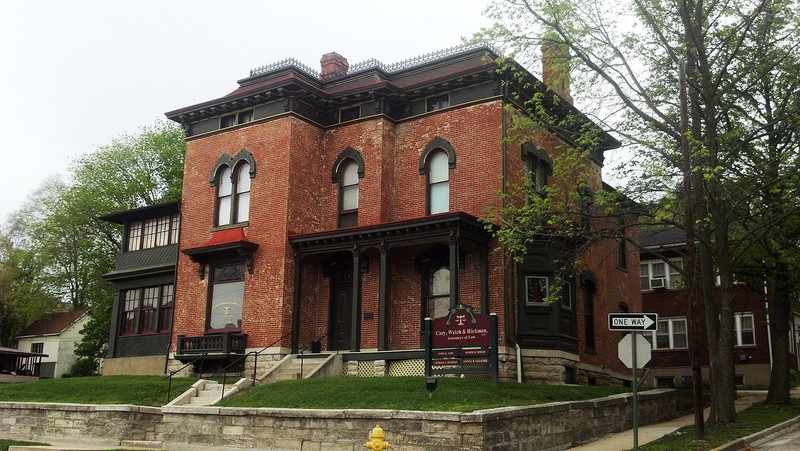Ebert-Dulany House
Introduction
Text-to-speech Audio
The Ebert-Dulany House, constructed around 1865-1870 in Hannibal, is an exemplary Second Empire style home. William C. Ebert, who worked for newspapers and printing companies, built the historic home. Later, George W. Dulany, whose family existed among Hannibal's elite lumber-industry barons, purchased the house. Dulany proved significant in diversifying Hannibal's industrial base when the decline of the lumber industry at the turn of the century threatened the city's future.
Images
Ebert-Dulany House

Backstory and Context
Text-to-speech Audio
William C. Ebert had lived in Hannibal since before the Civil War when he partnered with William League at the Daily Messenger. He then formed a new partnership named Frazee, Ebert, & Co., and they subsequently purchased the paper from League in 1860. In 1863, as part of a new firm called Winchell, Ebert & Marsh, Ebert consolidated the Daily Messenger with the Palmyra (Missouri) Courier, the paper for which Mark Twain had worked when it operated in Hannibal from 1848-1855. (The resulting paper, now known as the Hannibal Courier-Post, has remained in business to this day.)
Ebert built the historic home in 1865, only a couple of years after the newspaper consolidation. The house enjoyed a Second Empire design style, a popular choice for homes and businesses at the time. The term, Second Empire speaks to the French designs associated with the reign of Napoleon III (1852-1870), or the nation's "second empire." Under Napoleon III, famed urban planner Eugene Haussmann and other builders transformed Paris into a city of grand boulevards and large buildings enjoying Renaissance-inspired architecture. The Second Empire architectural trend spread throughout Europe and the U.S. during the nineteenth century. In addition to operating the newspaper, Ebert's firm, which was incorporated in 1870, also printed blanks and blank books and became widely known, employing about fifty people. However, substantial financial losses in 1879 and 1880 resulted in the company's liquidation and forced Ebert to sell the historic home.
The home changed hands a few times during the 1880s until Fanny W. Dulany, wife of George William Dulany, bought the house in 1886. George W. Dulaney's father, William H. Dulany, spent twenty years as a tobacco farmer before moving to Hannibal in 1867 and thereupon establishing a lumber company in partnership with his brother. Hannibal benefited first from a steamboat and river trade industry, followed by a flourishing railroad and lumber industry, which boosted Hannibal's commercial growth and economic prosperity considerably. The Dulany family enjoyed tremendous success with their lumber operation, known as the Empire Lumber Company; they also owned an operated the Hannibal Saw Mill Company. George W. Dulany eventually served as manager of the family business.
However, despite Minnesota and Wisconsin once having bountiful forests, the timber companies depleted those natural resources, which meant less lumber available for processing in Hannibal by 1900. Thus, the Hannibal Saw Mill Company closed in 1901 after twenty years of business, and the Empire Lumber Company closed its doors a few years later. G. W. Dulany played a pivotal role in diversifying Hannibal's economy, which ostensibly saved the town from significant decline.
Dulany arranged for the Business Men's Association to purchase thirty-three acres of his lumber yard, which they offered free to new industries. He then helped organize the Bluff City Shoe Company, which became one of the first and most successful factories to locate in this new industrial district. In addition to aiding the town, his success in bringing in a new industry resulted in personal financial gain, demonstrated by improvements he made to the historic home during the first decade of the 1900s.
In 1911, Dulany underwrote roughly forty-two percent of the construction costs of the YMCA, and he bequeathed another $40 thousand to the organization when he died in 1923. Between those times, in 1917, George and Fanny Dulany sold their house and moved to Dallas, Texas, to be with their daughter.
During the Great Depression, the historic home was subdivided into apartments and a small retail business. In 1981, a restoration company specializing in historic preservation purchased the Ebert-Dulany house and then spent several years removing the subdivisions and restoring the home to its original design.
Sources
"Ebert-Dulany House." River City Restorations. Accessed November 16, 2022. http://www.rivercityrestorationsinc.com/ebertdulany.htm.
"Explore the History Museum." Hannibal History Museum. 2011. Accessed November 16, 2022. http://www.hannibalhistorymuseum.com/p/blog-page.html.
Fritz, David. L. "Special History Study on Logging and Lumbering as Associated with the Area Now Incorporated within the Present Bounds of Voyageurs National Park." August 1986. http://npshistory.com/publications/voya/logging-lumbering-shs.pdf.
Hamilton, Esley. "Nomination Form: Ebert-Dulany House." National Register of Historic Places. mostateparks.com. 1982. https://mostateparks.com/sites/mostateparks/files/Ebert-Dulany%20House.pdf.
Maunder, Elwood R. "Oral History Interview with George W. Dulany, Jr." Forest History Foundation, Inc. September 21, 1956. https://foresthistory.org/wp-content/uploads/2022/05/Dulany_George_W.pdf.
"Second Empire." Architectural Styles of America and Europe. Accessed November 9, 2022. https://architecturestyles.org/second-empire/.
"Why Local History Matters (for Hannibal)." Hannibal History Museum. December 2012. Accessed November 16, 2022. http://www.hannibalhistorymuseum.com/2012/12/why-local-history-matters-for-hannibal.html.
"The William Ebert House, Hannibal, MO." The Picturesque Style: Italianate Architecture (blog). April 27, 2016. http://picturesqueitalianatearchitecture.blogspot.com/2016/04/the-william-ebert-house-hannibal-mo.html.
By Sa magnuson33 - Own work, CC BY-SA 3.0, https://commons.wikimedia.org/w/index.php?curid=35451111
